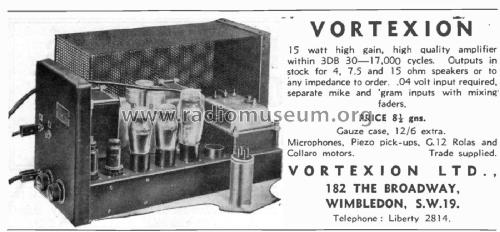15 Watt AC-DC Amplifier CP20
Vortexion Ltd.; Wimbledon
- Country
- Great Britain (UK)
- Manufacturer / Brand
- Vortexion Ltd.; Wimbledon
- Year
- 1937
- Category
- Audio Amplifier or -mixer
- Radiomuseum.org ID
- 340142
Click on the schematic thumbnail to request the schematic as a free document.
- Number of Tubes
- 4
- Number of Transistors
- Semiconductors
- Vibrator
- Main principle
- Audio-Amplification
- Wave bands
- - without
- Power type and voltage
- Line / Storage batteries (perhaps also batteries) / 230/12 Volt
- Loudspeaker
- - This model requires external speaker(s).
- Material
- Metal case, TUBES VISIBLE
- from Radiomuseum.org
- Model: 15 Watt AC-DC Amplifier CP20 - Vortexion Ltd.; Wimbledon
- Shape
- Chassis only or for «building in»
- Notes
-
The CP20 small portable amplifier is designed to operate either from the AC mains or from a 12-volt battery, and it is rated to give 15 watts of undistorted power output.
There are three stages using American-type valves; the first is resistance-capacity coupled to the following stage, while this, in turn, is coupled to a pair of 6B5 valves in push-pull by a parallel-fed centre-tapped choke of very high inductance.
The 6B5 valve is a special type of double-triode output valve in which the output section is cathode-coupled to the driver portion, the coupling being in the valve.
For microphone reproduction, the two preamplifiers are used, but for gramophone, only one is needed to give the full output.
The pick-up jack is, therefore, connected to the grid of the second valve. In this grid circuit are two independent volume controls, and it is thus possible to adjust the gain of the amplifier for the same power output from both sources, as well as superimpose one on the other, or fade one out and bring the other up to full volume.
When it is desired to operate the amplifier from a 12-volt battery, a four-pin plug on the chassis is removed and an HT vibrator is fitted in its place. This device is quite silent in action and provides the necessary HT voltage to operate the amplifier at full volume.
With the valves fitted for normal AC operation, the amplifier consumes between 6.5 and 7 amps at 12 volts, but this can be reduced to about 5 amps by replacing the HT rectifying valve, a Type 83, by the Type BA, which is a cold-cathode rectifier and thus leads to a saving of 3 amps in filament current.
During tests on the amplifier its undistorted power output was measured, and the frequency response was checked from 30 c /s. to 20,000 c /s.
An output of 14.7 watts was obtained without any trace of distortion, so the rating of 15 watts is quite justified in this case since only a small percentage of harmonics is present at this power.
The curve reproduced here shows the measured response of the amplifier, which, allowing an arbitrary variation of ±5 dB. compared with 400 c /s, has an upper limit of 18,000 c /s. and a lower of 3o c/s. As the output transformer was included in the test circuit, its performance is exceptionally good for a versatile amplifier costing 12 guineas complete. Another outstanding feature of this amplifier is its exceptionally low hum level when AC operated even without an earth connection.
In order to obtain the maximum undistorted output, an input to the microphone jack of 0.037 volts was required. Thus, the overall gain is adequate for most types of high-grade transverse current carbon microphone or other styles giving a comparable output.
The secondary of the output transformer is tapped for loudspeakers or line impedances of 4, 7.5, and 15 ohms.This model is described as the CP20, and an amplifier with a similar circuit and power output is also available for AC operation only, in which form the price is 8½: guineas.
These prices do not include the perforated cover, which costs 12s. 6d. extra, or the Type BA rectifier, the substitution of which adds one guinea to the price.
Wireless World, Oct 1, 1937, Page 342See also later version CP20A
- Price in first year of sale
- 8.95 GB £
- Mentioned in
- Wireless World (The), London (WW, 79) (Oct 1, 1937, Page 342)
- Author
- Model page created by Gary Cowans. See "Data change" for further contributors.
- Other Models
-
Here you find 23 models, 20 with images and 1 with schematics for wireless sets etc. In French: TSF for Télégraphie sans fil.
All listed radios etc. from Vortexion Ltd.; Wimbledon

